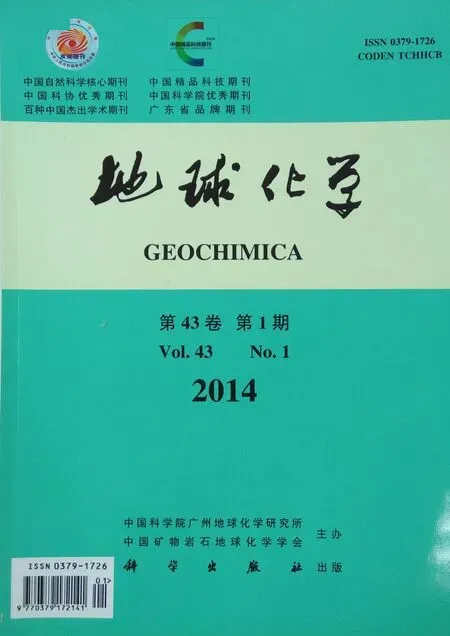湘南上堡花岗岩中电气石LA-MC-ICPMS原位微区硼同位素分析及地质意义
郭海锋, 夏小平, 韦刚健, 王 强*, 赵振华,黄小龙, 张海祥, 袁 超, 李武显
湘南上堡花岗岩中电气石LA-MC-ICPMS原位微区硼同位素分析及地质意义
郭海锋1,2, 夏小平1, 韦刚健1, 王 强1*, 赵振华1,黄小龙1, 张海祥1, 袁 超1, 李武显1
(1. 中国科学院 广州地球化学研究所 同位素地球化学国家重点实验室, 广东 广州 510640; 2. 中国科学院大学, 北京 100049)
电气石的LA-MC-ICPMS原位微区硼同位素分析方法是最近几年新兴的一种高效经济的硼同位素分析方法。对上堡晚白垩世含电气石二云母花岗岩的电气石进行LA-MC-ICPMS原位微区的硼同位素研究发现, 其具有非常均一的11B/10B比值(3.9908~3.9979)和11B值(加权平均为(‒12.86±0.19)‰)。结合区域地质资料以及其他已有的硼同位素资料, 提出上堡花岗岩中硼来源于沉积岩, 可能的源区是邻近花岗岩体的石炭-二叠纪的沉积地层或深埋在地壳中的沉积物质。在晚白垩世, 华南处于伸展的背景中, 幔源岩浆的底侵带来的巨大的热源使地壳中的沉积物质发生熔融, 形成强过铝质的花岗质浆, 在岩浆演化的晚期形成电气石。
LA-MC-ICPMS; 原位硼同位素; 电气石; 上堡花岗岩; 华南
0 引 言
硼是典型的地壳元素, 也是高度不相容元素和高流体活动性元素[1‒2], 因而其在地幔中丰度非常低, 在海水和大陆地壳中比较高[3]。硼有两个稳定同位素,10B 和11B, 其自然界丰度分别为19.9%和80.1%。由于10B和11B之间的相对质量差大(Δ/≈0.1), 所以其在自然过程中同位素分馏效应十分明显。自然过程中硼同位素组成变化非常大, 不同储库的11B值变化为‒37‰ ~ +58‰[4‒8], 因而在地球化学示踪研究中应用比较广泛。近年来, 硼同位素在揭示星云形成过程和宇宙事件、壳-幔演化、板块俯冲作用过程、矿床成因以及示踪古海洋、古气候演变等方面的研究中发挥了重要作用[9]。硼的同位素分馏用11B来描述, 其定义为:
11B(‰)= ((11B/10B)样品/(11B/10B)标准–1)×1000
其中硼同位素的标准为美国国家标准局的SRM 951硼酸。
长期以来, 受分析技术的制约, 硼同位素的应用研究发展不如一些经典的同位素体系如Sr-Nd-Hf等迅速, 主要的技术难点如下: (1)质谱测定过程中硼同位素分馏大, 但由于硼只有两种稳定同位素, 无法进行有效的校正[10‒11]; (2)在化学前处理过程中, 如溶样、分离过程中, 往往难以保证100%的回收率而无法有效控制硼丢失带来的分馏问题[10‒12]; (3)分析过程中的混染、基体效应以及记忆效应等难以有效去除[11,13,14]; (4)不同的实验室采用不同的分析方法、校正得出来的结果存在明显的差异[11]。
目前国际上对硼同位素的测定方法主要分为两类。一类是传统的溶液法(酸溶、碱熔、高温水解法)[13,15,16], 将样品溶解后提纯出硼, 用正热离子质谱(P-TIMS)、负热离子质谱(N-TIMS)和多接收电感耦合等离子质谱(MC-ICPMS)等来测量硼同位素比值[13,17‒19]。对于基体比较复杂的硅酸盐样品来说, 这一方法难度非常大, 尤其是化学前处理过程异常繁琐复杂, 极大地限制了其应用。另一类是微区原位分析法, 适用于高硼含量的矿物, 如电气石等, 主要是用离子探针[20‒21]或激光剥蚀多接收电感耦合等离子体质谱(LA-MC-ICPMS)[13,22,23]直接对矿物进行原位硼同位素比值测定。离子探针分析相对成本较高, 目前在对基体效应的校正还不够成熟, 分析精度还不够理想[14,23]。LA-MC-ICPMS原位微区硼同位素测定最早于2004年由Le Roux.[23]从传统的溶液分析方法中复制出来, 并且在对新鲜的MORB岩石测定中取得了非常理想的效果。国内, 侯可军等[22]曾成功地建立此方法, 并应用到了对电气石、钠硼解石等实际地质样品的LA-MC-ICPMS微区原位硼同位素的测定, 分析结果与溶液法测定的结果在误差范围内达到一致。
含硼矿物的原位硼同位素分析方法虽然使用的时间不长, 但已经展示出非常广泛的应用前景和巨大的使用潜力[13,24]。相对于离子探针, 其基体效应的影响相对小一些, 分析精度也较高且成本较低;相对溶液法, 不仅避免了繁杂的化学纯化分离流程, 并且具有低的仪器记忆效应和背景值、高的灵敏度和用样量少等特点[23], 还可以对矿物的环带和微层等进行原位分析以揭示矿物形成的精细过程和条件[13,22]。
电气石是地壳中最为重要的含硼矿物, 对岩石成因具有指示意义。这是因为电气石的成分(如主元素和微量元素)变化范围大, 可以很灵敏地指示其寄主岩的组成[25]。同时, 电气石在很高的温度压力条件下, 以及在后续的蚀变和风化过程中均有较高的稳定性, 能有效地保留原岩的信息[25]。此外电气石中的硼与锡以及其他成矿的亲石元素存在络合关系, 在探矿和反映成矿环境方面也发挥出重要的作用[26]。
湘南上堡含电气石二云母花岗岩体是华南的一个成矿花岗岩体, 有硫黄铁矿-萤石晶体矿和W-Sn-Nb-Ta等矿床与其密切共生[27‒29]。本研究利用同位素地球化学国家重点实验室最近建立起来的LA-MC-ICPMS电气石的硼同位素原位分析方法, 对湖南上堡含电气石二云母花岗岩中的电气石进行原位硼同位素测定, 拟通过对上堡岩体中电气石进行原位硼同位素的测定, 追踪硼的来源, 探讨花岗岩岩浆的物质来源, 为进一步了解其成岩成矿机制提供基础资料。
1 区域地质背景
研究区域位于湖南南部的耒阳县。该区从晚古生代至早三叠一直是较为稳定的浅海-滨海地区, 形成了厚度较大、岩相较为稳定的碳酸盐建造、含煤建造。早三叠至早侏罗世发生了印支运动, 印支期褶皱发育较普遍。燕山运动对早期的构造层的影响仅表现为断裂, 并伴随有强烈的岩浆活动。区域内在燕山晚期主要处于一种伸展的地质背景中[30‒31], 主要表现为正断层和地堑, 并伴随有小规模的酸性和基性岩浆岩出露, 以及小规模的内生金属成矿作用。区域内的岩浆活动与构造部位有着密切关系, 一般基底断裂为大规模的岩浆活动提供了通道[32‒34], 如郴州-临武二级断裂带和五华-新邵二级断裂带交叉穿过该地区, 上侵的岩浆占据了穹窿和背斜的核部, 小岩体、岩墙也与次一级的断裂及背斜密切相关, 而热液矿床一般位于岩浆岩接触带、断裂带和背斜的核部。
上堡岩体位于耒阳县黄市镇上堡街附近, 侵入于晚古生代石炭-二叠系地层中(图1), 岩体周围发育着大面积的大理岩化和小面积的夕卡岩化, 岩体出露面积大约为1.5 km2。其中大理岩化的岩石产黄铁矿, 夕卡岩化岩石则伴生W、Sn、Be、Li等矿床, 岩体内部发生钠长石化是重要的内生金属矿床。前人对上堡岩体的研究显示其周围赋存大量与之相关的多金属矿床, 其中上堡硫黄铁矿-萤石晶体矿是世界级的晶体标本矿床, 此外周围还分布着W-Sn-Nb-Ta等多金属矿床[27‒29]。区域内的沉积建造储藏有煤、黄铁矿和菱铁矿等一些沉积矿床。前人对上堡岩体进行了全岩的Rb-Sr等时线定年和黑云母的K-Ar定年, 分别得到了85、92和104 Ma的年龄, 显示其形成于燕山晚期[32]。
上堡岩体主要由含电气石二云母花岗岩组成, 并伴有大量镁铁质岩墙(图1)。本文研究的样品(11SHB10: 112°58′01″E, 26°12′57″N)采自上堡花岗岩侵入体的中心相, 岩性为含电气石二云母花岗岩, 岩石具有不等粒似斑状结构, 含粗粒的钾长石晶体, 矿物体积百分数为: 钾长石(35%,)、钠长石(30%)、石英(30%)、黑云母(3%)、电气石(约1%)和白云母(约1%), 副矿物主要有锆石和黄铁矿(图2)。电气石呈浸染状分布于花岗岩内(图2a), 具有类似深熔形成的强过铝质花岗岩中的原生电气石的特征[35]。手标本新鲜无蚀变, 测得的烧失量(LOI=0.59%, 课题组未发表数据)和显微照片(图2b)也支持样品没有蚀变。电气石从钠长石的核部析出, 并平行于其双晶纹的方向生长, 所以上堡花岗岩中的电气石是一种岩浆结晶形成的原生电气石[24]。
2 实验方法
采自上堡岩体中心相的新鲜全岩样品, 通过机械破碎和液选法分选出粒径为0.1~1 mm的电气石颗粒, 在双目显微镜下于玻璃板上固定好之后以环氧树脂充填固结制成靶, 将其进行抛光, 进行透射光和反射光照相, 筛选出最佳的分析点(图3)。
电气石的LA-MC-ICPMS微区原位硼同位素的分析测定在中国科学院广州地球化学研究所同位素地球化学国家重点实验室完成, 分析所使用的仪器为Thermo Finnigan 公司生产的Neptune Plus多接收等离子体质谱仪及与之相匹配的美国Resonetics LLC 公司生产的RESOlution M-50激光剥蚀系统。以法拉第杯对硼的两个同位素信号同时静态接收(L3接收10B, H3接收11B)。实验分析所使用的束斑直径为45 μm, 剥蚀频率为5 Hz, 激光输出能量为100 mJ, 经过50%的衰减后作用于样品表面。其具体的分析步骤类似于侯可军等[22]和Le Roux.[23]所述: 以He气作为载气, 将剥蚀产生的气溶胶吹出, 通过三通与Ar气混合载入MC-ICPMS的等离子体进行离子化。开始正式测定之前先以线扫描国际原子能机构的电气石硼同位素标样IAEA B4[36]对仪器参数进行调试, 使之达到最佳状态。数据采集所用的积分时间为0.131 s, 共采集400 组数据, 耗时约为54 s, 前面27 s不开激光, 测试气体空白, 27 s剥蚀样品。在分析过程中采用每10个未知样品点前后分别分析2个标样点, 以4个标样点的平均值校正未知样品的方法, 来消除仪器质量歧视和同位素分馏。以IAEA B4为标准, 其11B值采用Gonfiantini.[37]报道的3个不同实验室P-TIMS结果平均值(-8.71±0.18)‰, 以中国地质科学院矿产资源研究所电气石标样IMR RB2作为监控标样, 本实验测试中2个IMR RB2分析点给出的11B结果分别为(-12.67±0.54)‰ (2)和(-12.86± 0.56)‰ (2), 跟侯可军等[22]报道的(-12.53±0.57)‰ (2σ)在误差范围内完全一致。
3 分析结果
电气石原位微区测试点的分析结果见表1, 共测试28个分析点, 其中2个点明显位于平均值的2范围之外, 其余的26个点具有较为一致的硼同位素比值(3.9908~3.9979), 计算的11B(‰)值介于-13.62‰ ~ -11.87‰之间。利用ISOPLOT version 3.7软件[40], 我们计算了这26个点的11B的加权平均值, 结果为(-12.86±0.38)‰(2σ)(图3a)。另外2个点(3号和26号)的11B值分别为-14.94‰和-9.29‰, 可能代表不同来源的电气石。
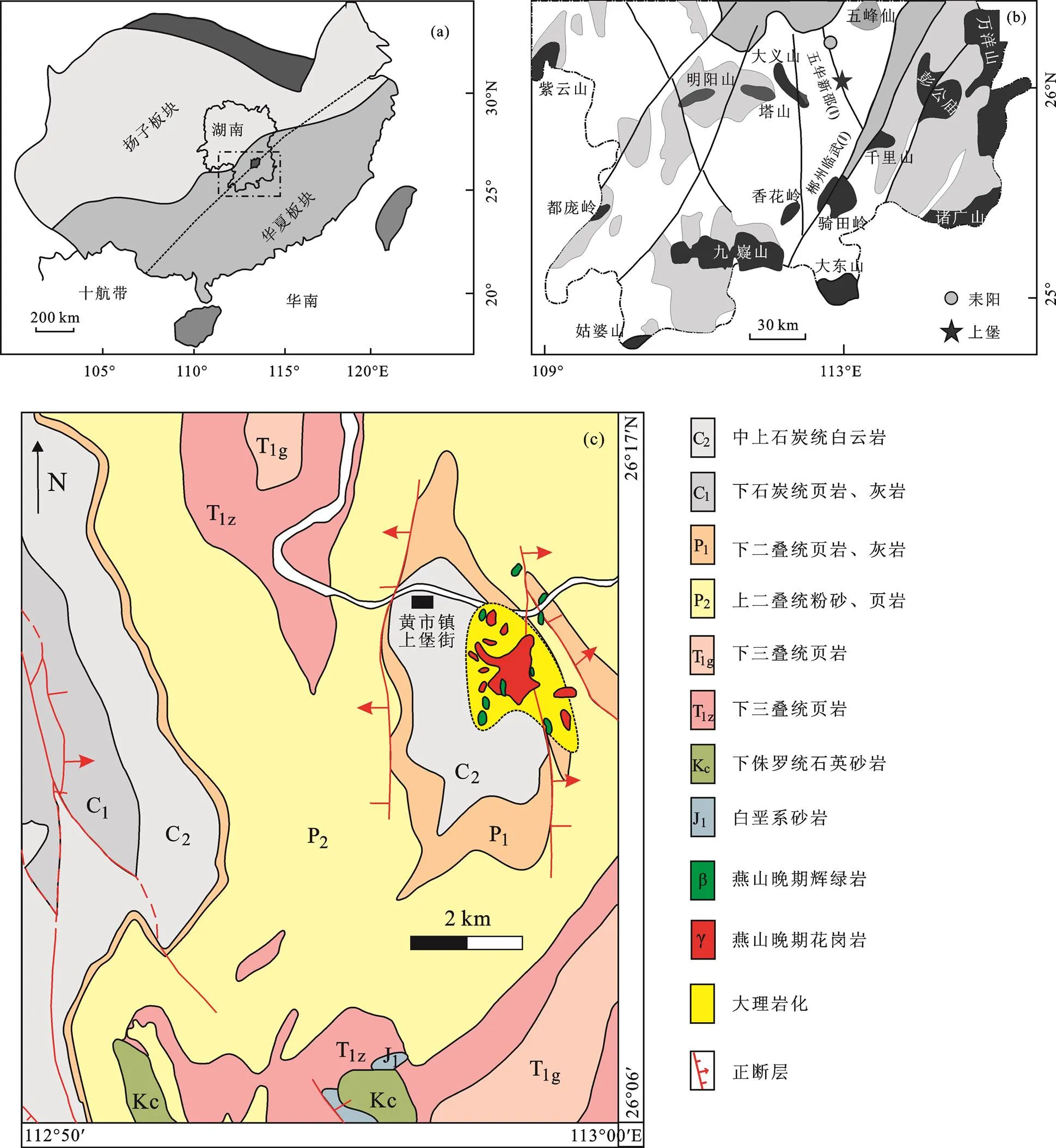
图1 华南地块简图(a)、湘南地质简图(b)及上堡晚白垩含电气石花岗岩分布地质简图(c, 据1961年湖南区域地质图编)
上述结果表明, 上堡含电气石二云母花岗岩中的电气石拥有较为均一的11B值, 而且这个值与大陆地壳的平均值(-10±3)‰[41‒43]很接近, 也与报道的岩浆热液电气石的大概范围 (约为-12.6‰)[8,41,43‒47]一致。
4 讨论与结论
电气石作为地壳中最主要的含硼矿物, 可以在极宽的温压范围内稳定, 如从地表一直到上地幔深度的压力条件下都可存在[3,48]。其一旦形成, 源区的化学和同位素信息即基本上保留, 因为即使温度上了600 ℃, 主元素和微量元素的体积扩散也不明显。电气石在沉积物的转移、成岩和变质过程中也是异常的稳定, 与锆石、金红石并称为沉积地质的三大“超稳定的矿物”[49]。这种优良的物理稳定性使得其相对于全岩更加适合用来反映其结晶时的寄主岩的硼同位素信息[49]。岩相学的特征表明, 上堡花岗岩中的电气石为原生电气石(图2), 其均一的硼同位素特征表明电气石结晶时岩浆内硼同位素达到了均一化。
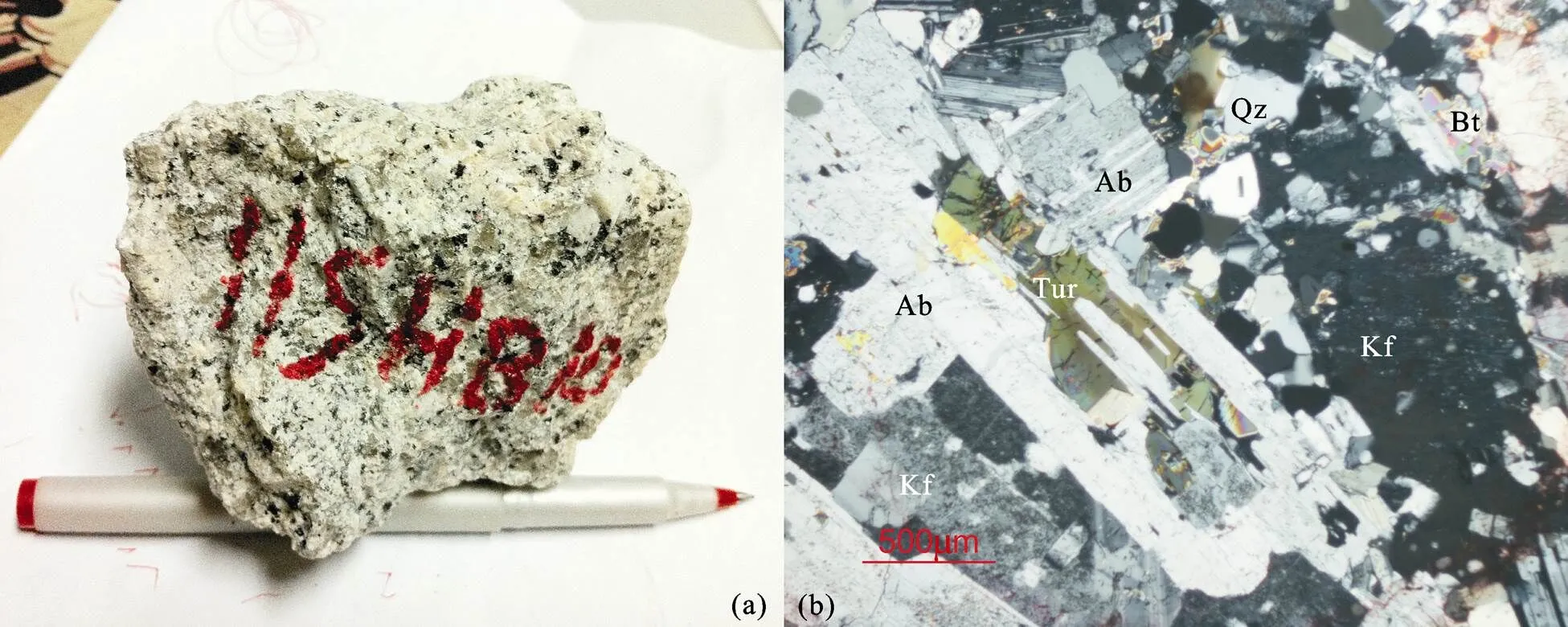
图2 上堡含电气石花岗岩手标本(a)及显微照片(b)
显微照片中,可见电气石从钠长石的斑晶中析出。Tur-电气石; Ab-钠长石; Kf-钾长石; Qz-石英; Bt-黑云母
Fig.2 (a) the Shangbao turmaline-bearing granite; (b) Photomicrograph showing the Turmaline crystalized from an albite crystal Tur‒turmaline; Ab‒albite; Kf‒K feldspar; Qz‒quartz; Bt‒biotite
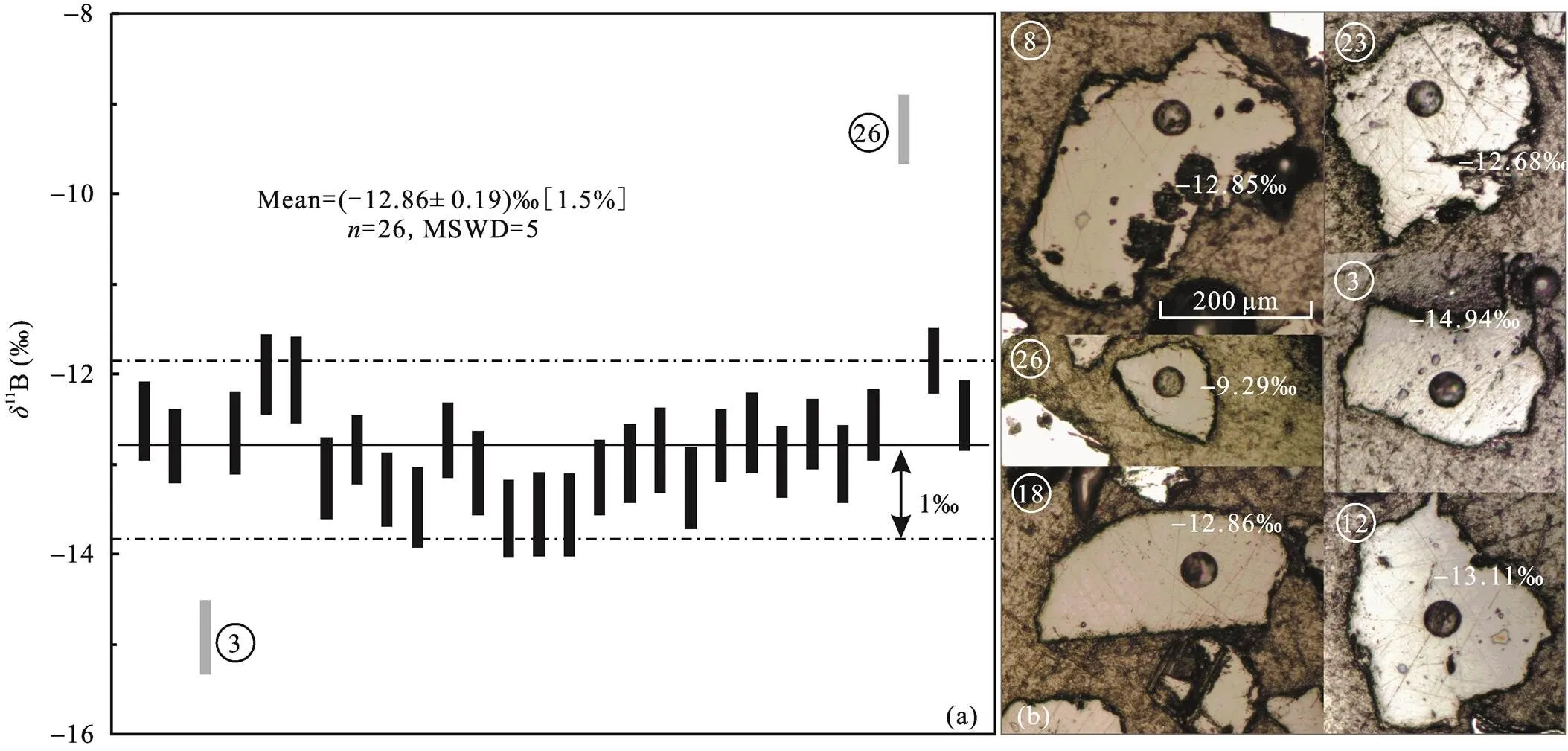
图3 上堡花岗岩中电气石的δ11B加权平均值(灰色两点除外)(a)和代表性的电气石反射光图像以及对应的δ11B值(b)
已有的研究显示, 来自碎屑的变质沉积物和变火山岩层的电气石有着中等的11B值, 从-15.7‰至-1.5‰, 来自海相变蒸发岩和碳酸盐相关的地层中的电气石有着更加高的11B值, 一般大于0‰[50‒52], 与非海相蒸发岩有关的澳大利亚Broken Hill 矿床中的电气石则有着较负的11B值, 从-26.8‰至-17.2‰[51,53]。
有关花岗岩中电气石的研究表明, 一般来自壳源沉积物的花岗岩中的原生电气石有着非常类似的11B值, 与平均地壳值接近[39‒41]。Slovakia 的Western Carpathians 的电气石研究表明, 从岩浆中结晶出来的原生电气石有着与平均大陆地壳接近的11B值, 从-10.3‰到-15.4‰, 而结晶于变质流体中的电气石有着更加轻的硼同位素组成(-16.0‰~ -17.1‰)[54]。Finland的Erajarvi和 Kietyonmaki 的花岗伟晶岩中的原生电气石的11B值变化范围为-10.2‰ ~ -13.2‰[55]。Yang.[24]在对香山火成杂岩体中的电气石研究中发现, 岩浆结晶晚期热液出溶形成的原生电气石有着非常均一的11B值, 为-14‰ ~ -11‰, 认为其形成于一个单一的壳源硼源区。Jiang.[56]通过对华南与花岗岩有关的锡矿床的电气石的研究和统计发现,11B值变化范围为-19.5‰ ~ -13.9‰, 暗示这些富锡的花岗岩来自变质沉积岩基底或者区域的火山岩。Zhao.[57]对骑田岭芙蓉矿床的花岗岩全岩样品的硼同位素研究得到早期高温(大于450 ℃)结晶的新鲜样品有着中等的11B值, 为-10.9‰, 而低温下(约350 ℃)下的大气水对花岗岩的风化蚀变使得具有异常低的11B值,为-21.9‰ ~ -27.3‰)。上堡电气石中有着类似来自壳源的原生电气石的11B值, 总体较为均一(-12.86±0.38)‰ (表1), 接近大陆地壳值[6], 反映其源区可能主要为变质沉积岩[56]。但是有2个分析点的组成明显异于其他电气石(表1), 其中3号点 (11B=-14.94‰)的组成也接近大陆地壳值[6], 指示花岗岩的源岩也应为变质沉积岩[56]。26号点(11B = -9.29‰)的组成则介于大陆地壳和洋中脊玄武岩(MORB)+地幔值的重叠区域[6], 显示花岗岩在形成的过程中, 除了变质沉积岩外, 或许有少量变质火成岩组分或幔源组分的加入。从野外地质特征(图1c)上来看, 上堡含电气石二云母花岗岩与基性岩墙密切共生, 这说明少量幔源岩浆活动参与上堡花岗岩的形成的可能性是存在的, 但更详细的岩石学、地球化学的研究工作仍在进行中。
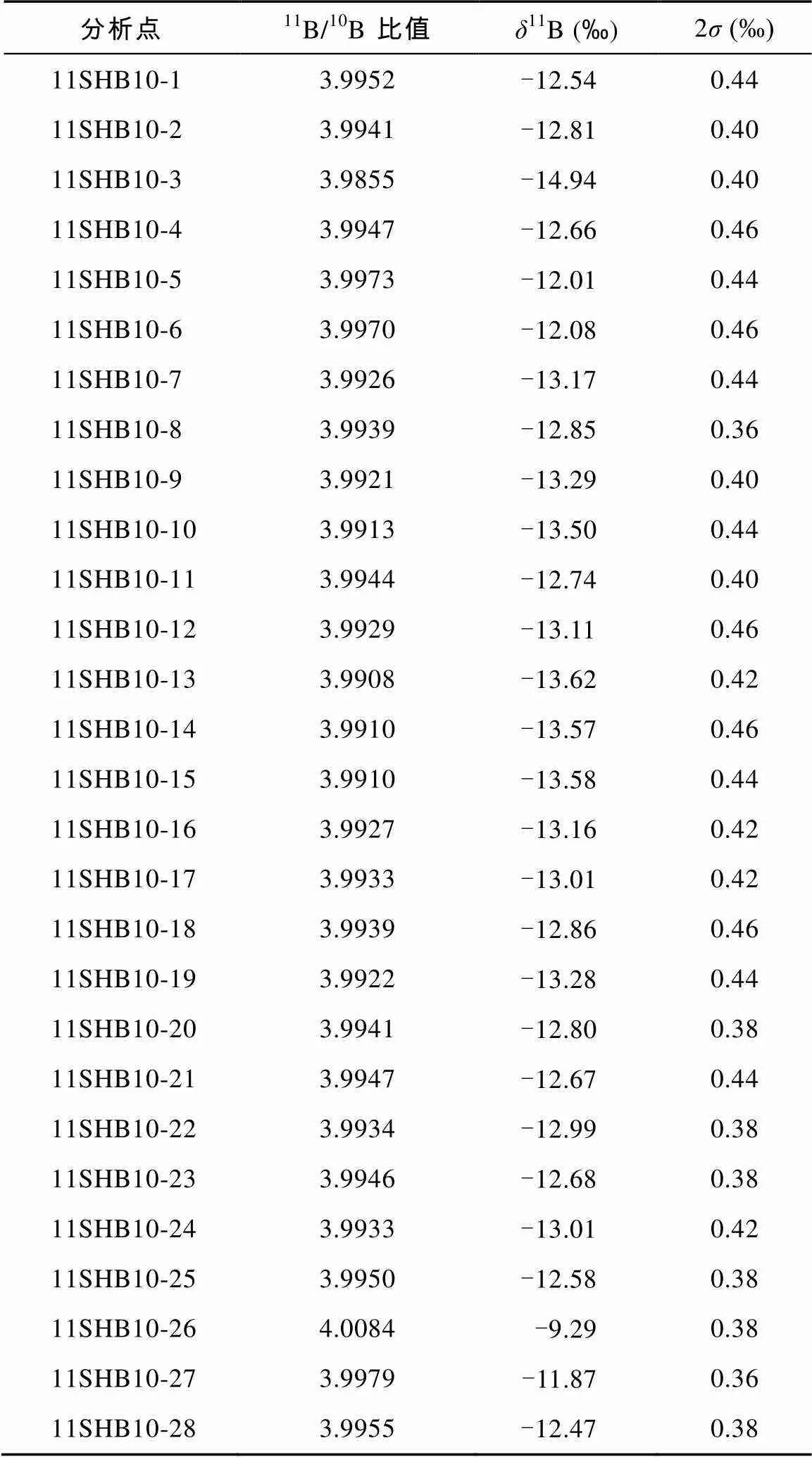
表1 上堡花岗岩中电气石的LA-MC-ICPMS原位硼同位素分析结果
注: (1)实验条件: 5 Hz 45μm, 100 mJ 50%; (2)11B/10B Ratio为IAEA B4标样校正后的比值, 具体方法见Le Roux.[23]; (3)11B 所采用的公式为11B(‰)=((11B/10B)样品/(11B/10B)标准–1)×1000, 其中标准为美国国家标准局(NBS)的SRM 951硼酸样品, 其(11B/10B)标准比值推荐值为4.05003[38‒39]
上堡含电气石二云母花岗岩是典型的强过铝质花岗岩。这种强过铝质花岗岩代表一种纯的地壳熔体[58‒64]。Partiño Douce[63‒64]也从实验岩石学的角度证实了世界上最典型的淡色花岗岩高喜马拉雅淡色花岗岩(主要为含电气石二云母花岗岩)是由变质沉积岩部分熔融直接形成的。因此, 上堡含电气石二云母花岗岩可能主要为地壳沉积岩熔融形成。
结合已有的文献资料和上堡研究区中基本的地质资料及野外地质特征(即岩体侵入到石炭-二叠系地层中, 图1c), 我们认为上堡花岗岩中电气石的硼同位素可能主要来源于沉积岩, 这与其寄主岩的岩浆成因相吻合, 而最可能的源区就是邻近花岗岩体的石炭-二叠系的沉积地层或深埋在地壳中的沉积物质。在晚白垩世, 整个华南处于伸展的构造背景中[30‒31], 幔源岩浆的底侵带来的巨大的热源[65‒66]使得地壳中的沉积物质发生熔融形成强过铝质的花岗岩浆[63]。硼同位素在岩浆中达到均一化, 并在岩浆结晶晚期结晶出来, 从图2b可见晚期的电气石从早期结晶的钠长石斑晶中析出。
中国地质科学院矿产资源研究所侯可军博士提供了本次实验中使用的标准电气石样品IAEA B4和IMR RB2; 野外和实验过程中得到了任钟元研究员、关义立和钟军伟的支持和帮助, 在此一并表示感谢。
[1] McDonough W F, Sun S-s. The composition of the Earth[J]. Chem Geol, 1995, 120(9): 223–253.
[2] Ryan J G, Langmuir C H. The systematics of boron abundances in young volcanic rocks[J]. Geochim Cosmochim Acta, 1995, 57(16): 1489–1498.
[3] Dutrow B L, Henry D J. Tourmaline: A geologic DVD[J]. Elements, 2011, 7(5): 301–306.
[4] Barth S. Boron isot ope variations in nature: A synthesis[J]. Geol Rundsch, 1993, 82(4): 640–651.
[5] Bassett R L. A critical evaluation of the available measurements for the stable isotopes of boron[J]. Appl Geochem, 1990, 5(5/6): 541–554.
[6] Marschall H R, Jiang Shao-Yong. Tourmaline Isotopes: No Element Left Behind[J]. Elements, 2011, 7(5): 313–319.
[7] Palmer M R, Swihart G H. Boron isotope geochemistry: An overview[J]. Rev Mineral, 1996, 33(1): 709–744.
[8] Jiang S Y, Palmer M R. Boron isotope systematics of tourmaline from granites and pegmatites: A synthesis[J] . Eur J Mineral, 1998, 10(6): 1253–1265.
[9] 蒋少涌. 硼同位素及其地质应用研究[J]. 高校地质学报, 2000, 6(1): 1–16.
Jiang Shao-yong. Boron isotope and its geological applications[J]. Geol J China Univ, 2000, 6(1): 1–16 (in Chinese with English abstract).
[10] 肖应凯, 刘卫国, 魏海珍. 硼同位素测定的进展及存在的问题[J]. 质谱学报, 1998, 19(4): 65–74.
Xiao Ying-kai, Liu Wei-guo, Wei Hai-zhen. The progress and problems in isotopic measurement of boron[J]. J Mass Spectrom, 1998, 19(4): 65–74 (in Chinese with English abstract).
[11] Fietzke J, Heinemann A, Taubner I, Böhm F, Erez J, Eisenhauer A. Boron isotope ratio determination in carbonates via LA-MC-ICP-MS using soda-lime glass standards as reference material[J]. J Anal Atom Spectrom, 2010, 25(12): 1953–1957.
[12] 吕苑苑, 赵平, 高剑峰, 许荣华. 硼同位素分析方法研究进展[J]. 地质科学, 2009, 44(3): 1052–1061.
Lü Yuan-yuan, Zhao Ping, Gao Jian-feng, Xu Rong-hua. Advances in boron isotope determinations[J]. Chinese J Geol, 2009, 44(3): 1052–1061 (in Chinese with English abstract).
[13] Aggarwal J K, Palmer M R.Boron isotope analysis: A review[J]. Analyst, 1995, 120(5): 1301–1307.
[14] Sylvester P J. Trends in analytical developments and earth science applications in LA-ICP-MS and LA-MC-ICP-MS for 2004 and 2005[J]. Geostandard Geoanal Res, 2006, 30(3): 197–207.
[15] Musashi M, Oi T, Ossaka T, Kakihana H. Extraction of boron from GSJ rock reference samples and determination of their boron isotopic ratios[J]. Anal Chim Acta, 1990, 231(1): 147–150.
[16] Spivack A J, Edmond J M. Determination of boron isotope ratios by thermal ionization mass spectrometry of the dicesium metaborate cation[J]. Anal Chem, 1986, 58(1):31–35.
[17] Aggarwal J K , Mezger K , Pernicka E, Meixner A. The effect of instrumental mass bias on11B measurements: A comparison between thermal ionisation mass spectrometry and multiple-collector ICP-MS[J]. Int J Mass Spectrom, 2004, 232(3): 259–263.
[18] Deyhle A. Improvements of boron isotope analysis by positive thermal ionization mass spectrometry using static multicollection of Cs2BO2+ions[J]. Int J Mass Spectrom, 2001, 206(1/2): 79–89.
[19] Barth S. Boron isotopic analysis of natural fresh and saline waters by negative thermal ionization mass spectrometry[J]. Chem Geol, 1997, 143(3/4): 255–261.
[20] Chaussidon M, Robert F, Mangin D, Hanon P, Rose E F. Analytical procedures for the measurement of boron isotope compositions by ion microprobe in Meteorites and mantle rocks[J]. Geostand Newslett, 1997, 21(1): 7–17.
[21] Kobayashi K, Tanaka R, Moriguti T, Shimizu K, Nakamura E. Lithium, boron and lead isotope systematics of glass inclusions in olivines from Hawaiian lavas: Evidence for recycled components in the Hawaiian plume[J]. Chem Geol, 2004, 212(1/2): 143–161.
[22] 侯可军, 李延河, 肖应凯, 刘峰, 田有荣. LA-MC-ICP-MS 硼同位素微区原位测试技术[J]. 科学通报, 2010, 55(22): 2207–2213.
Hou Kejun, Li Yanhe, Xiao Yingkai, Liu Feng, Tian Yourong. LA-MC-ICP-MSboron isotope measure technique[J]. Chinese Sci Bull, 2010, 55(22): 2207–2213 (in Chinese).
[23] Le Roux P J, Shirey S B, Benton L, Hauri E H, Mock T D., multiple-multiplier, laser ablation ICP-MS measurement of boron isotopic composition (11B) at the nanogram level[J]. Chem Geol, 2004, 203(1/2): 123–138.
[24] Yang Shui-Yuan, Jiang Shao-Yong. Chemical and boron isotopic composition of tourmaline in the Xiangshan volcanic-intrusive complex, Southeast China: Evidence for boron mobilization and infiltration during magmatic- hydrothermal processes[J]. Chem Geol, 2012, 312–313(18): 177–189.
[25] van Hinsberg V J, Henry D J, Marschall H R. Tourmaline: An ideal indicator of its host environment[J]. Can Mineral, 2011, 49(1): 1–16.
[26] Wolf M B, London D. Boron in granitic magmas: Stability of tourmaline in equilibrium with biotite and cordierite[J]. Contrib Mineral Petrol, 1997, 130(1): 12–30.
[27] 陈湘立, 金艳辉, 谢慈国. 湖南耒阳上堡花岗岩风化壳型铌钽矿床铌钽的赋存状态[J].矿物学报, 2003, 23(4): 323–326.
Chen Xiang-li, Jin Yan-hui, Xie Ci-guo. Occurrence of niobium and tantalum in the Nb-Ta deposit in weathered granite crust at Shangbao, Leiyang, Hunan province[J]. Acta Mineral Sinica, 2003, 23(4): 323–326 (in Chinese with English abstract).
[28] 雷泽恒, 乔玉生, 许以明. 湖南上堡矿区钨锡矿成矿条件及找矿前景分析[J]. 地质与勘探, 2009, 45(2): 44–52.
Lei Ze-heng, Qiao Yu-sheng, Xu Yi-ming. W-Sn mineralization characteristics and exploration potential of the Shangbao mineral district, Hunan Province[J]. Geol Prospect, 2009, 45(2): 44–52 (in Chinese with English abstract).
[29] 穆治国, 郑淑蕙, 曹正民. 湖南耒阳上堡硫铁矿床矿物及其包体的氢、氧、碳稳定同位素研究[J]. 地质论评, 1982, 28(4): 367–369.
Mu Zhi-guo, Zheng Shu-hui, Cao Zheng-min. Hydrogen, oxygen and carbon isotope studies of the minerals and their fluid inclusions in the Shangbao pyrite deposit, Leiyang county, Hunan province[J]. Geol Rev, 1982, 28(4): 367–369 (in Chinese with English abstract).
[30] Li Zhenxiang, Li Xianhua. Formation of the 1300-km-wide intracontinental orogen and postorogenic magmatic province in Mesozoic South China: A flat-slab subduction model[J]. Geology, 2007, 35(2): 179–182.
[31] Li Zheng-Xiang, Li Xian-Hua, Chung Sun-Lin, Lo Ching-Hua, Xu Xisheng, Li Wu-Xian. Magmatic switch-on and switch-off along the South China continental margin since the Permian: Transition from an Andean-type to a Western Pacific-type plate boundary[J]. Tectonophysics, 2012, 532–535: 271–290.
[32] 郭令智, 施央申, 马瑞士. 西太平洋中、新生代活动大陆边缘和岛弧构造的形成及演化[J]. 地质学报, 1983, 57(1): 11–21.
Guo Ling-zhi, Shi Yang-shen, Ma Rui-shi. On the formation and evolution of the Mesozoic-Cenozoic active continental margin and island arc tectonics of the western Pacific Ocean[J]. Acta Geol Sinica, 1983, 57(1): 11–21 (in Chinese with English abstract).
[33] 范蔚茗, 王岳军, 郭锋, 彭头平. 湘赣地区中生代镁铁质岩浆作用与岩石圈伸展[J]. 地学前缘, 2003, 10(3): 159–169.
Fan Wei-ming, Wang Yue-jun, Guo Feng, Peng Tou-ping. Mesozoic mafic magmatism in Hunan-Jiangxi provinces and the lithospheric extension[J]. Earth Sci Front, 2003, 10(3): 159–169 (in Chinese).
[34] 梁新权, 郭定良. 湖南深部构造活化及其浅部响应[J]. 地质科学, 2002, 37(3): 332–342.
Liang Xin-quan, Guo Ding-liang. Deep tectonic activation and its shallow response in Hunan province[J]. Chinese J Geol, 2002, 37(3): 332–342 (in Chinese with English abstract).
[35] London D, Morgan G B, Wolf M B. Boron in granitic rocks and their contact aureoles[J]. Rev Mineral Geochem, 1996, 33: 299–330.
[36] Tonarini S, Pennisi M, Adorni-Braccesi A, Dini A, Ferrara G, Gonfiantini R,Wiedenbeck M, Gröning M. Intercomparison of boron isotope and concentration measurements. Part I: Selection, preparation and homogeneity tests of the intercomparison materials[J]. Geostandard Geoanal Res, 2003, 27(1): 21–39.
[37] Gonfiantini R, Tonarini S, Groning M, Adorni-Braccesi A, Al-Ammar A S, Astner M, Bächler S, Barnes R M, Bassett R L, Cocherie A, Deyhle A , Dini A, Ferrara G, Gaillardet J, Grimm J, Guerrot C, Krähenbühl U, Layne G, Lemarchand D, Meixner A, Northington J, Pennisi M, Reitznerová E, Rodushkin I, Sugiura N, Surberg R, TonS. Intercomparison of boron isotope and concentration measurements. Part II: Evaluation of results[J]. Geostandard Geoanal Res, 2003, 27(1): 41–57.
[38] Ishikawa T, Tera F. Source, composition and distribution of fluid in the Kurile mantle wedge: Constraints from across-arc variations of B/Nb and B isotopes[J]. Earth Planet Sci Lett, 1997, 152(1–4): 123–138.
[39] Ishikawa T, Tera F, Nakazawa T. Boron isotope and trace element systematics of the three volcanic zones in the Kamchatka arc[J]. Geochim Cosmochim Acta, 2001, 65(24): 4523–4537.
[40] Ludwig K R. User’s Manual for Isoplot3.0[R]. Berkeley Geochronological Center Special Publication No.4. 2003.
[41] Chaussidon M, Albarède F. Secular boron isotope variations in the continental crust: An ion microprobe study[J]. Earth Planet Sci Lett, 1992, 108(4): 229–241.
[42] Kasemann S, Erzinger J, Franz G. Boron recycling in the continental crust of the central Andes from the Palaeozoic to Mesozoic, NW Argentina[J]. Contrib Mineral Petrol, 2000, 140(3): 328–343.
[43] Marschall H R, Ludwig T. Re-examination of the boron isotopic composition of tourmaline from the Lavicky granite, Czech Republic, by secondary ion mass spectrometry: Back to normal[J]. Geochem J, 2006, 40(6): 631–638.
[44] Palmer M R, Swihart G H. Boron isotope geochemistry: An overview[J]. Rev Mineral Geochem, 1996, 33(1): 709–744.
[45] Nakano T, Nakamura E. Boron isotope geochemistry of metasedimentary rocks and tourmalines in a subduction zone metamorphic suite[J]. Phys Earth Planet In, 2001, 127(1–4): 233–252.
[46] Matthews A, Putlitz B, Hamiel Y, Hervig R L. Volatile transport during the crystallization of anatectic melts: Oxygen, boron and hydrogen stable isotope study on the metamorphic complex of Naxos, Greece[J]. Geochim Cosmochim Acta, 2003, 67(17): 3145–3163.
[47] Trumbull R, Krienitz M S, Gottesmann B, Wiedenbeck M. Chemical and boron-isotope variations in tourmalines from an S-type granite and its source rocks: The Erongo granite and tourmalinites in the Damara Belt, Namibia[J]. Contrib Mineral Petrol, 2008, 155(1): 1–18.
[48] Marschall H R, Korsakov A V, Luvizotto G L, Nasdala L, Ludwig T. On the occurrence and boron isotopic composition of tourmaline in (ultra) high-pressure metamorphic rocks[J]. J Geol Soc, 2009, 166(4): 811–823.
[49] Van Hinsberg VJ, Henry D J, Dutrow B L. Tourmaline as a petrologic forensic mineral: A unique recorder of its geologic past[J]. Elements, 2011, 7(5): 327–332.
[50] Slack J F, Palmert M R, Stevens B P J. Boron isotope evidence for the involvement of non-marine evaporites in the origin of the Broken Hill ore deposits[J]. Nature, 1989, 342(6252): 913–916.
[51] Palmert M R, Slack J F. Boron isotopic composition of tourmaline from massive sulfide deposits and tourmalinites[J]. Contrib Mineral Petrol, 1989, 103(4): 434–451.
[52] Pal D C, Trumbull R B, Wiedenbeck M. Chemical and boron isotope compositions of tourmaline from the Jaduguda U(-Cu-Fe) deposit, Singhbhum shear zone, India: Implications for the sources and evolution of mineralizing fluids[J]. Chem Geol, 1989, 277(3/4): 245–260.
[53] Slack J F, Palmer M R, Stevens B P J, Barnes R G. Origin and significance of tourmaline-rich rocks in the Broken Hill District, Australia[J]. Econ Geol, 1993, 88(3): 505–541.
[54] Jiang S Y, Radvanec M, Nakamurac E, Palmerd M, Kobayashic K, Zhao Hai-Xiang, Zhao Kui-Dong. Chemical and boron isotopic variations of tourmaline in the Hnilec granite-related hydrothermal system, Slovakia: Constraints on magmatic and metamorphic fluid evolution[J]. Lithos, 2008, 106(1/2): 1–11.
[55] Talikka M, Vuori S. Geochemical and boron isotopic compositions of tourmalines from selected gold-mineralised and barren rocks in SW Finland[J]. Bull Geol Soc Finland, 2010, 82(2): 113–128.
[56] Jiang Shao-yong. Boron isotope geochemistry of hydrothermal ore deposits in China: A preliminary study[J]. Phys Chem Earth Solid Earth Geodes, 2001, 26(9/10): 851–858.
[57] Zhao Kui-Dong, Jiang Shao-Yong, Nakamura E, Moriguti T, Palmer M R, Yang Shui-Yuan, Dai Bao-Zhang, Jiang Yao-Hui. Fluid-rock interaction in the Qitianling granite and associated tin deposits, South China: Evidence from boron and oxygen isotopes[J]. Ore Geol Rev, 2011, 43(1): 243–248.
[58] Barbarin B. Genesis of the two main types of peraluminous granitoids[J]. Geology, 1996, 24(4): 295–298.
[59] Barbarin B. A review of the relationships between granitoid types, their origins and their geodynamic environments[J]. Lithos, 1999, 46(3): 605–626.
[60] Sylvester P J. Post-collisional strongly peraluminous granites[J]. Lithos, 1998, 45(1–4): 29–44.
[61] Visonà D, Lombardo B. Two-mica and tourmaline leucogranites from the Everest-Makalu region (Nepal-Tibet). Himalayan leucogranite genesis by isobaric heating?[J]. Lithos, 2002, 65(3/4): 125–150.
[62] Wang Qiang, Chung Sun-lin, Li Xian-hua, Wyman D, Li Zhen-xiang, Sun Wei-dong, Qiu Hua-ning, Liu Yong-sheng, Zhu Ying-tang. Crustal melting and flow beneath northern Tibet: Evidence from Mid-Miocene to Quaternary strongly peraluminous rhyolites in southern Kunlun Range[J]. J Petrol, 2012, 53(12): 2523–2566.
[63] Patiño Douce A E, Harris N. Experimental constraints on Himalayan anatexis[J]. J Petrol, 1998, 39(4): 689–710.
[64] Partiño Douce A E. What do experiments tell us about the relative contributions of crust and mantle to the origin of granitic magmas?[J]. Geol Soc London, 1999, 168(1): 55–75.
[65] Jiang Yao-Hui, Jiang Shao-Yong, Dai Bao-Zhang, Liao Shi-Yong, Zhao Kui-Dong, Ling Hong-Fei. Middle to late Jurassic felsic and mafic magmatism in southern Hunan province, southeast China: Implications for a continental arc to rifting[J]. Lithos, 2009, 107(3/4): 185–204.
[66] Wang Yuejun, Fan Weiming, Guo Feng, Peng Touping, Li Chaowen. Geochemistry of Mesozoic mafic rocks adjacent to the Chenzhou-Linwu fault, South China: Implications for the lithospheric boundary between the Yangtze and Cathaysia blocks[J]. Int Geol Rev, 2003, 45(3): 263–286.
LA-MC-ICPMSboron isotope analyses of tourmalines from the Shangbao granites (southern Hunan Province) and its geological significance
GUO Hai-feng1,2, XIA Xiao-ping1, WEI Gang-jian1, WANG Qiang1*, ZHAO Zhen-hua1, HUANG Xiao-long1, ZHANG Hai-xiang1,YUAN Chao1and LI Wu-xian1
1. State Key Laboratory of Isotope Geochemistry, Guangzhou Institute of Geochemistry, Chinese Academy of Sciences, Guangzhou 510640, China; 2. University of Chinese Academy of Sciences, Beijing 100049, China
LA-MC-ICPMS tourmalineboron (B) isotope analysis method, which is very efficient and economic, was newly established in recent few years. The LA-MC-ICPMS tourmalineB isotope analyses for the Shangbao tourmaline-bearing two mica granites exhibit that these tourmalines have very constant11B/10B ratios (3.9908‒3.9979) and11B values (Mean= (‒12.86±0.19)‰). Combined with regional geological data and other previous boron isotope data, we infer that the B element of the Shangbao granites was probably derived from sedimentary rocks, and a possible source was the Carboniferous or Permian sedimentary strata which is near to the Shangbao pluton, or sedimentary materials which were deeply buried in the crust. During Late Cretaceous, as the whole South China Block was under an extensional setting, the underplating mantle-derived magmas heated the overlying sedimentary materials, resulting in their partial melting and the generation of strongly peraluminous magmas. The tourmaline crystallized during the late stage of the evolution of these magmas.
LA-MC-ICPMS;B isotope; tourmaline; Shangbao pluton; South China
P597
A
0379-1726(2014)01-0011-09
2013-03-28;
2013-04-09;
2013-04-24
国家自然科学基金(41025006, 41073029, 41121002); 国家重点基础研究发展计划项目(2012CB416703)
郭海锋(1988–), 男, 硕士研究生, 岩石地球化学专业。E-mail: ghyphon@126.com
WANG Qiang, E-mail: wqiang@gig.ac.cn; Tel: +86-20-85290277

